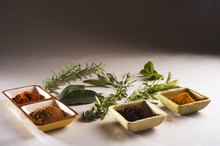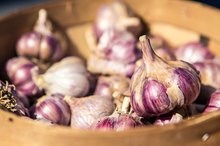What does fact checked mean?
At Healthfully, we strive to deliver objective content that is accurate and up-to-date. Our team periodically reviews articles in order to ensure content quality. The sources cited below consist of evidence from peer-reviewed journals, prominent medical organizations, academic associations, and government data.
- "Journal of Reproductive Medicine"; Advances In the Understanding of Bacterial Vaginosis; J.L. Thomason, et al.; August 1989
- "Journal of Reproductive Medicine"; Advances In the Understanding of Bacterial Vaginosis; J.L. Thomason, et al.; August 1989
- "BMC Infectious Diseases"; The Epidemiology of Bacterial Vaginosis In Relation To Sexual Behavior; H. Verstraehlen, et al.; March 2010
- "BMC Infectious Diseases"; The Epidemiology of Bacterial Vaginosis In Relation To Sexual Behavior; H. Verstraehlen, et al.; March 2010
- "Pakistani Journal of Pharmaceutical Science"; Anti-mycobacterial Activity of Garlic (Allium sativum) Against Multi-drug Resistant and Non-multi-drug Resistant Mycobacterium Tuberculosis; H. Hannan, et al.; January 2011
- "Pakistani Journal of Pharmaceutical Science"; Anti-mycobacterial Activity of Garlic (Allium sativum) Against Multi-drug Resistant and Non-multi-drug Resistant Mycobacterium Tuberculosis; H. Hannan, et al.; January 2011
- "Obstetrical & Gynecological Survey"; Common Complementary and Alternative Therapies for Yeast Vaginitis and Bacterial Vaginosis: A Systematic Review; K. Van Kessel, et al.; May 2003
- "Obstetrical & Gynecological Survey"; Common Complementary and Alternative Therapies for Yeast Vaginitis and Bacterial Vaginosis: A Systematic Review; K. Van Kessel, et al.; May 2003
- "Journal of Maternal-fetal & Neonatal Medicine"; Comparative Efficacy of Probiotic Yoghurt and Clindamycin In Treatment of Bacterial Vaginosis In Pregnant Women: A Randomized Clinical Trial; S. Hantoushzadeh, et al.; August 2011
- "Journal of Maternal-fetal & Neonatal Medicine"; Comparative Efficacy of Probiotic Yoghurt and Clindamycin In Treatment of Bacterial Vaginosis In Pregnant Women: A Randomized Clinical Trial; S. Hantoushzadeh, et al.; August 2011
- "Microbes and Infections"; Antimicrobial Properties of Allicin From Garlic; S. Ankri, et al.; 1999
- "Microbes and Infections"; Antimicrobial Properties of Allicin From Garlic; S. Ankri, et al.; 1999
The information contained on this site is for informational purposes only, and should not be used as a substitute for the advice of a professional health care provider. Please check with the appropriate physician regarding health questions and concerns. Although we strive to deliver accurate and up-to-date information, no guarantee to that effect is made.
Clove of Garlic for Bacterial Vaginosis
Bacterial vaginosis, the most common gynecological infection, is characterized by a foul-smelling vaginal discharge caused by an overgrowth of non-peroxide-producing bacteria. This infection is usually not sexually transmitted, but frequent intercourse may change the vaginal environment and make women more susceptible to developing this condition. Most women choose antibiotic treatment, but because this disorder has a high recurrence rate, some women seek natural remedies. Consult your doctor for more information.
If you are experiencing serious medical symptoms, seek emergency treatment immediately.
Warning: Get a Proper Diagnosis
There are two reasons for visiting a doctor before treating yourself for vaginosis. The first is to confirm a diagnosis of vaginosis and not some other condition, like a sexually transmitted disease, that could impair your fertility. The second is that you must determine whether you need to take antibiotics. Left untreated, bacterial vaginosis has serious consequences that can include premature labor, abscesses and pelvic inflammatory disease, which can lead to blocked fallopian tubes and thus interfere with your ability to conceive.
- There are two reasons for visiting a doctor before treating yourself for vaginosis.
- The first is to confirm a diagnosis of vaginosis and not some other condition, like a sexually transmitted disease, that could impair your fertility.
Antibacterial Properties of Garlic
Herbal Treatment for Chlamydia
Learn More
A February 1999 paper reviewing the medicinal properties of garlic and published in "Microbes and Infections" found that garlic exhibited antimicrobial properties against a wide variety of bacteria, including strains that were resistant to multiple antibiotics 6. This product also shows antiviral, antifungal and antiparasitic actions as well. More recent research published in the January 2011 issue of the "Pakistani Journal of Pharmaceutical Science" showed that garlic extracts were effective against drug-resistant strains of tuberculosis bacteria as well 3.
Garlic and Vaginosis
Even though in vitro studies demonstrate that garlic has antibacterial properties, most research on its effectiveness in treating vaginosis is inconclusive. According to a May 2003 review of alternative medical treatments published in the "Obstetrical & Gynecological Survey," garlic is indeed widely used to treat vaginosis, but there is a lack of good-quality studies demonstrating its effectiveness 4. In the authors' opinion, more randomized, controlled clinical trials are needed before doctors can recommend this substance for the condition.
Probiotics
Antibiotics to Treat Cystitis
Learn More
If you decide against using garlic but are still searching for a natural treatment, you may want to try probiotics. Research published in the August 2011 issue of the "Journal of Maternal-fetal & Neonatal Medicine" found that eating 100 grams of probiotic yogurt twice a day was nearly as effective as the antibiotic clindamycin 5. In this study, 140 patients in the probiotic group and 141 patients in the antibiotic group experienced a complete symptomatic cure.
Related Articles
References
- "Journal of Reproductive Medicine"; Advances In the Understanding of Bacterial Vaginosis; J.L. Thomason, et al.; August 1989
- "BMC Infectious Diseases"; The Epidemiology of Bacterial Vaginosis In Relation To Sexual Behavior; H. Verstraehlen, et al.; March 2010
- "Pakistani Journal of Pharmaceutical Science"; Anti-mycobacterial Activity of Garlic (Allium sativum) Against Multi-drug Resistant and Non-multi-drug Resistant Mycobacterium Tuberculosis; H. Hannan, et al.; January 2011
- "Obstetrical & Gynecological Survey"; Common Complementary and Alternative Therapies for Yeast Vaginitis and Bacterial Vaginosis: A Systematic Review; K. Van Kessel, et al.; May 2003
- "Journal of Maternal-fetal & Neonatal Medicine"; Comparative Efficacy of Probiotic Yoghurt and Clindamycin In Treatment of Bacterial Vaginosis In Pregnant Women: A Randomized Clinical Trial; S. Hantoushzadeh, et al.; August 2011
- "Microbes and Infections"; Antimicrobial Properties of Allicin From Garlic; S. Ankri, et al.; 1999
- Kairys N, Garg M. Bacterial Vaginosis. [Updated 2019 May 4]. In: StatPearls [Internet]. Treasure Island (FL): StatPearls Publishing; 2019 Jan-. Available from: https://www.ncbi.nlm.nih.gov/books/NBK459216/
- Reiter S, Kellogg spadt S. Bacterial vaginosis: a primer for clinicians. Postgrad Med. 2019;131(1):8-18.
- Bilardi J, Walker S, McNair R, et al. Women's Management of Recurrent Bacterial Vaginosis and Experiences of Clinical Care: A Qualitative Study. PLoS One. 2016;11(3):e0151794. Published 2016 Mar 24. doi:10.1371/journal.pone.0151794
- Koumans EH, Sternberg M, Bruce C, et al. The prevalence of bacterial vaginosis in the United States, 2001-2004; associations with symptoms, sexual behaviors, and reproductive health. Sex Transm Dis. 2007;34(11):864-9.
- Kumar N, Behera B, Sagiri SS, Pal K, Ray SS, Roy S. Bacterial vaginosis: Etiology and modalities of treatment-A brief note. J Pharm Bioallied Sci. 2011;3(4):496–503. doi:10.4103/0975-7406.90102
- McDonald HM, Brocklehurst P, Gordon A. Antibiotics for treating bacterial vaginosis in pregnancy. Cochrane Database Syst Rev. 2007;(1):CD000262. Published 2007 Jan 24. doi:10.1002/14651858.CD000262.pub3
- Kairys N, Garg M. Bacterial Vaginosis. [Updated 2019 May 4]. In: StatPearls [Internet]. Treasure Island (FL): StatPearls Publishing; 2019 Jan-.
- Kumar N, Behera B, Sagiri SS, Pal K, Ray SS, Roy S. Bacterial vaginosis: Etiology and modalities of treatment-A brief note. J Pharm Bioallied Sci. 2011;3(4):496–503. doi:10.4103/0975-7406.90102
- Muzny CA, Schwebke JR. Pathogenesis of Bacterial Vaginosis: Discussion of Current Hypotheses. J Infect Dis. 2016;214 Suppl 1(Suppl 1):S1–S5. doi:10.1093/infdis/jiw121
- Mackelprang RD, Scoville CW, Cohen CR, et al. Toll-like receptor gene variants and bacterial vaginosis among HIV-1 infected and uninfected African women. Genes Immun. 2015;16(5):362–365. doi:10.1038/gene.2015.13
- Money D. The laboratory diagnosis of bacterial vaginosis. Can J Infect Dis Med Microbiol. 2005;16(2):77–79. doi:10.1155/2005/230319
- Cook RL, Reid G, Pond DG, Schmitt CA, Sobel JD. Clue cells in bacterial vaginosis: immunofluorescent identification of the adherent gram-negative bacteria as Gardnerella vaginalis. J Infect Dis. 1989;160(3):490-6.
- Bradshaw CS, Sobel JD. Current Treatment of Bacterial Vaginosis-Limitations and Need for Innovation. J Infect Dis. 2016;214 Suppl 1(Suppl 1):S14–S20. doi:10.1093/infdis/jiw159
- Menard JP. Antibacterial treatment of bacterial vaginosis: current and emerging therapies. Int J Womens Health. 2011;3:295–305. doi:10.2147/IJWH.S23814
- Homayouni A, Bastani P, Ziyadi S, et al. Effects of probiotics on the recurrence of bacterial vaginosis: a review. J Low Genit Tract Dis. 2014;18(1):79-86.
- Muzny CA, Schwebke JR. Pathogenesis of Bacterial Vaginosis: Discussion of Current Hypotheses. J Infect Dis. 2016;214 Suppl 1(Suppl 1):S1–S5. doi:10.1093/infdis/jiw121
- Allworth, J. and Peipert, J. Severity of Bacterial Vaginosis and the Risk of Sexually Transmitted Infection.Am J Obstet Gynecol. 2011; 205(2):113.e1-113.e6. doi:10.1016/j.ajog.2011.02.060.
- Bagnall, P. and Rizzolo, D. Bacterial vaginosis: A practical review.J Am Acad Phys Assist. 2017; 30(12):15-21. doi:10.1097/01.JAA.0000526770.60197.fa.
- CDC. Bacterial Vaginosis (BV) Statistics: Bacterial vaginosis is the most common vaginal infection in women ages 15-44. Updated December 17, 2015.
- Centers for Disease Control and Prevention. 2015 Sexually Transmitted Diseases Treatment Guidelines: Bacterial Vaginosis. Atlanta, Georgia; updated June 4, 2015.
- Hainer, B. and Gibson, M. Vaginitis: Diagnosis and Treatment. Am Fam Physician. 2011; 83(7):807-815.
Writer Bio
Jessica Ramer began writing professionally in 2000. She has been published in "Macrobiotics Today" and has also written "Charlie Does the SAT Math." Ramer is a Kushi Institute-certified macrobiotic instructor who holds a B.A. in mathematics and a M.A. in psychology from Florida Atlantic University.








